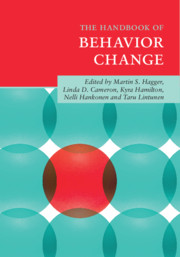Book contents
- The Handbook of Behavior Change
- The Handbook of Behavior Change
- Copyright page
- Dedication
- Contents
- Figures
- Tables
- Sidebars
- Contributors
- 1 Changing Behavior: A Theory- and Evidence-Based Approach
- Part I Theory and Behavior Change
- Part II Methods and Processes of Behavior Change: Intervention Development, Application, and Translation
- Part III Behavior Change Interventions: Practical Guides to Behavior Change
- 31 Attitudes and Persuasive Communication Interventions
- 32 Self-Efficacy Interventions
- 33 Imagery, Visualization, and Mental Simulation Interventions
- 34 Affect-Based Interventions
- 35 Autonomy-Supportive Interventions
- 36 Incentive-Based Interventions
- 37 Monitoring Interventions
- 38 Goal Setting Interventions
- 39 Planning and Implementation Intention Interventions
- 40 Self-Control Interventions
- 41 Habit Interventions
- 42 Economic and Behavioral Economic Approaches to Behavior Change
- 43 Dyadic Behavior Change Interventions
- 44 Social Identity Interventions
- 45 Motivational Interviewing Interventions
- 46 The Science of Behavior Change: The Road Ahead
- Index
- References
34 - Affect-Based Interventions
from Part III - Behavior Change Interventions: Practical Guides to Behavior Change
Published online by Cambridge University Press: 04 July 2020
- The Handbook of Behavior Change
- The Handbook of Behavior Change
- Copyright page
- Dedication
- Contents
- Figures
- Tables
- Sidebars
- Contributors
- 1 Changing Behavior: A Theory- and Evidence-Based Approach
- Part I Theory and Behavior Change
- Part II Methods and Processes of Behavior Change: Intervention Development, Application, and Translation
- Part III Behavior Change Interventions: Practical Guides to Behavior Change
- 31 Attitudes and Persuasive Communication Interventions
- 32 Self-Efficacy Interventions
- 33 Imagery, Visualization, and Mental Simulation Interventions
- 34 Affect-Based Interventions
- 35 Autonomy-Supportive Interventions
- 36 Incentive-Based Interventions
- 37 Monitoring Interventions
- 38 Goal Setting Interventions
- 39 Planning and Implementation Intention Interventions
- 40 Self-Control Interventions
- 41 Habit Interventions
- 42 Economic and Behavioral Economic Approaches to Behavior Change
- 43 Dyadic Behavior Change Interventions
- 44 Social Identity Interventions
- 45 Motivational Interviewing Interventions
- 46 The Science of Behavior Change: The Road Ahead
- Index
- References
Summary
This chapter provides an overview of the use of affect-based interventions to change behavior. Affect is defined in terms of affect proper and affect processing; both of these terms are used regularly in research on affect interventions. The evidence of direct modification of these affect constructs is then reviewed. Based on this evidence, step-by-step guides to techniques focusing on changing two key aspects of affective processing are provided: changing affective attitudes and anticipated affect. The guides to these techniques include typical means of delivery, target audience, behaviors, enabling or inhibiting factors, training and skills required, intensiveness, typical materials needed, and typical examples of implementation. In addition, application of implementation intentions, fear appeals, evaluative conditioning, and exercise games as other ways to change affect as a means to changing behavior are reviewed. Finally, two additional intervention pathways that could have impact on behavior change are reviewed: direct modification of other sources of behavioral influence (e.g., traditional social cognitive factors) in order to overcompensate for the impact of affect and self-regulation of the intensity of the affect experience as a means of inhibiting its impact.
Keywords
Information
- Type
- Chapter
- Information
- The Handbook of Behavior Change , pp. 495 - 509Publisher: Cambridge University PressPrint publication year: 2020
